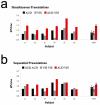Audio-visual speech cue combination
- PMID: 20419130
- PMCID: PMC2855706
- DOI: 10.1371/journal.pone.0010217
Audio-visual speech cue combination
Abstract
Background: Different sources of sensory information can interact, often shaping what we think we have seen or heard. This can enhance the precision of perceptual decisions relative to those made on the basis of a single source of information. From a computational perspective, there are multiple reasons why this might happen, and each predicts a different degree of enhanced precision. Relatively slight improvements can arise when perceptual decisions are made on the basis of multiple independent sensory estimates, as opposed to just one. These improvements can arise as a consequence of probability summation. Greater improvements can occur if two initially independent estimates are summated to form a single integrated code, especially if the summation is weighted in accordance with the variance associated with each independent estimate. This form of combination is often described as a Bayesian maximum likelihood estimate. Still greater improvements are possible if the two sources of information are encoded via a common physiological process.
Principal findings: Here we show that the provision of simultaneous audio and visual speech cues can result in substantial sensitivity improvements, relative to single sensory modality based decisions. The magnitude of the improvements is greater than can be predicted on the basis of either a Bayesian maximum likelihood estimate or a probability summation.
Conclusion: Our data suggest that primary estimates of speech content are determined by a physiological process that takes input from both visual and auditory processing, resulting in greater sensitivity than would be possible if initially independent audio and visual estimates were formed and then subsequently combined.
Conflict of interest statement
Figures



References
-
- Bresciani JP, Ernst MO, Drewing K, Bouyer G, Maury V, et al. Feeling what you hear: Auditory signals can modulate tactile tap perception. Experimental Brain Research. 2005;162:172–180. - PubMed
-
- Lopez-Moliner J, Soto-Faraco S. Vision affects how fast we hear sounds move. Journal of Vision. 2007;7:1–7. - PubMed
-
- McGurk H, MacDonald J. Hearing lips and seeing voices. Nature. 1976;264:746–748. - PubMed
-
- Pavani F, Spence C, Driver J. Visual capture of touch: out-of-the-body experiences with rubber gloves. Psychological Science. 2000;11:353–359. - PubMed
-
- Sekuler R, Sekuler AB, Lau R. Sound alters visual motion perception. Nature. 1997;385:308. - PubMed
Publication types
MeSH terms
LinkOut - more resources
Full Text Sources
Molecular Biology Databases

